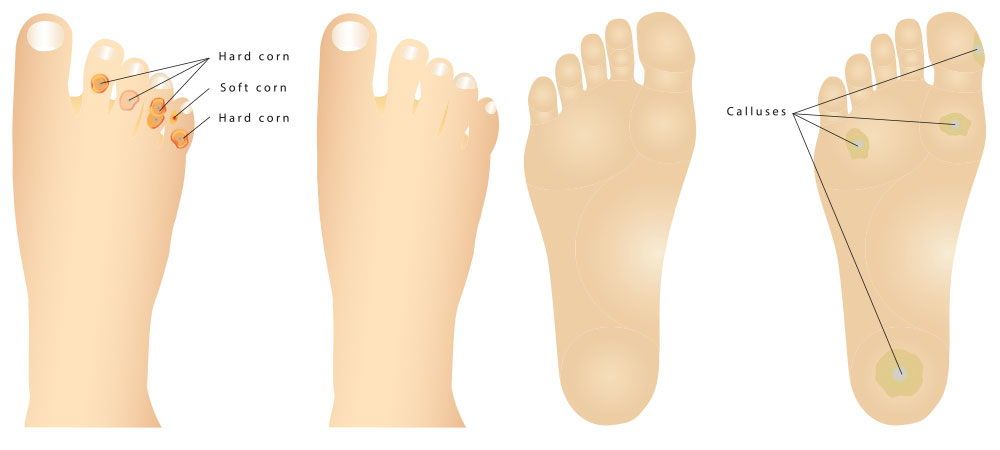Office Hours
- Mon-Fri 9:00a – 5:00p
Saturday Appt. Only
Sunday Closed
Contact Info
- Phone: 1-323-264-6157
Ask Us a Question
Corns and Calluses

What is a Corn? What is a Callus?
Corns and calluses are areas of thickened skin that develop to protect that area from irritation. They occur when something rubs against the foot repeatedly or causes excess pressure against part of the foot. The term callus commonly is used if the thickening of skin occurs on the bottom of the foot, and if thickening occurs on the top of the foot (or toe), it’s called a corn. However, the location of the thickened skin is less important than the pattern of thickening: flat, widespread skin thickening indicates a callus, and skin lesions that are thicker or deeper indicate a corn.
Corns and calluses are not contagious but may become painful if they get too thick. In people with diabetes or decreased circulation, they can lead to more serious foot problems.
Causes
Corns often occur where a toe rubs against the interior of a shoe. Excessive pressure at the balls of the feet—common in women who regularly wear high heels—may cause calluses to develop on the balls of the feet.
People with certain deformities of the foot, such as hammer toes, are prone to corns and calluses.
Symptoms
Corns and calluses typically have a rough, dull appearance. They may be raised or rounded, and they can be hard to differentiate from warts. Corns or calluses sometimes cause pain.
Home Care
Mild corns and calluses may not require treatment. If the corn or callus isn’t bothering you, it can probably be left alone. It’s a good idea, though, to investigate possible causes of the corn or callus. If your footwear is contributing to the development of a corn or callus, it’s time to look for other shoes.
Over-the-counter treatments can do more harm than good, especially if you have any medical conditions such as diabetes. Some over-the-counter treatments contain harsh chemicals, which can lead to burns or even foot ulcers.
When to Visit a Podiatrist
If corns or calluses are causing pain and discomfort or inhibiting your daily life in any way, see a podiatrist. Also, people with diabetes, poor circulation, or other serious illnesses should have their feet checked.
Diagnosis and Treatment
The podiatrist will conduct a complete examination of your feet. X-rays may be taken; your podiatrist may also want to inspect your shoes and watch you walk. He or she will also take a complete medical history. Corns and calluses are diagnosed based on appearance and history.
If you have mild corns or calluses, your podiatrist may suggest changing your shoes and/or adding padding to your shoes. Larger corns and calluses are most effectively reduced (made smaller) with a surgical blade. A podiatrist can use the blade to carefully shave away the thickened, dead skin—right in the office. The procedure is painless because the skin is already dead. Additional treatments may be needed if the corn or callus recurs.
Cortisone injections into the foot or toe may be given if the corn or callus is causing significant pain. Surgery may be necessary in cases that do not respond to conservative treatment.
Prevention
- Wear properly fitted shoes. If you have any deformities of the toe or foot, talk to your podiatrist to find out what shoes are best for you.
- Gel pad inserts may decrease friction points and pressure. Your podiatrist can help you determine where pads might be useful.
